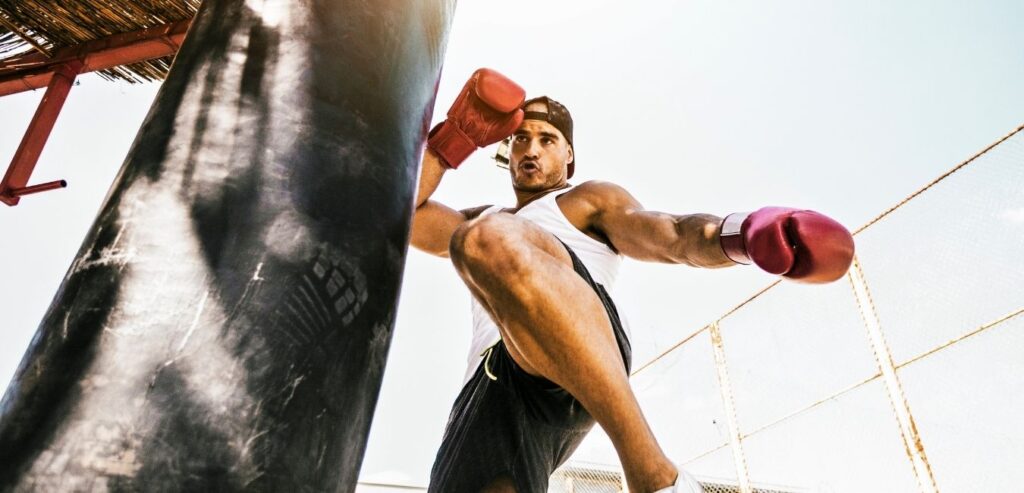
Nobody wants to spend hundreds of dollars on equipment when you’re trying out a new sport. What if you hate it? What if you suck at it? No one wants to throw away their hard earned money! So if you’re thinking about trying your hand at kickboxing, you’re probably not going to want to go out and buy a $300+ punching bag. This brings us to the question: can kickboxing be done without a bag?
As a beginning kickboxer, you can learn basic punching and kicking techniques without a bag, while getting an effective cardio workout. But if your ultimate goal is to improve power and strength in your strikes, or to learn how to fight or compete, you must eventually train with some type of resistance whether that be a bag, pads, or an opponent.
So you can do kickboxing without a bag, but there are many reasons to eventually fork out the money and buy one. Lets look at the reasons a punching bag is worth your money.
When Do You Need a Punching Bag?
Why do you need a punching bag if you’re kickboxing for more than just the cardio benefits? A punching bag, also called a heavy bag, provides the resistance to increase muscle strength. The more resistance (the heavier the bag), the harder your muscles have to work when your hand or foot makes contact with the bag.
If you are throwing punches only in the air, you will be able to get your heart pumping, but the lack of resistance will provide little to no gain in strength. So, if you are kickboxing only for weight loss or fitness benefits, a cardio kickboxing class at the gym or even online could be exactly what you’re looking for…no punching bag (or money out of pocket) needed!
Heavy bags can also help you to gain power in your punches. If you are choosing kickboxing to improve your fighting skills, or you want to train to compete, you will need to practice hitting hard, against something that resists your strikes. Without this resistance you would be unable to improve on the amount of force you are applying in your punches and kicks.
Hitting a bag will also provide a push back that will throw you off center just enough to force you to engage even more and different muscles to keep you on your feet. This constant requirement to regain your footing will improve your balance and coordination, both of which are key for combat and competition.
What You’ll Love About Using a Punching Bag
My first kickboxing classes were the cardio kickboxing kind…a bunch of people learning to throw kicks and punches into the air in a routine set to loud motivating music. I loved it! It was invigorating and fun!
But when I started taking classes using a punching bag, my world changed. You can’t compare the thrill of being able to really clobber a bag, to the feeling of simply throwing a left hook into the breeze. It’s so much more satisfying to smack that bag!
Not only do you get your heart rate moving and grooving, you can actually feel your muscles working. It’s incredibly empowering and motivating! This is what I love most about kickboxing with a punching bag. Honestly, it can make you feel like somewhat of a badass, even if you’re not!
How Do You Kickbox Without a Punching Bag?
If you aren’t ready to invest in a punching bag right away, you have a few alternatives.
The most inexpensive way to kickbox is actually free! It’s called shadow boxing. Shadow boxing is simply throwing punches and kicks into the air. Many fighters use shadow boxing to warm up their muscles before hitting the bag or sparing.
Shadow boxing is also often used in cardio kickboxing. You can find an abundance of videos on YouTube with shadow boxing tutorials. Just put on a video, hit play, and follow along. It’s that simple and that cheap!
But if you still want the resistance training you get from a punching bag without the expense of buying a bag, there are some options for you.
There are several different things you can use instead of a punching bag including punch mitts, kick pads, and wrist and ankle weights. If you’re not ready to spend the money on a heavy bag, these are great temporary alternatives to help you get started, and they’ll cost you less than $20.
If you have a partner you can train with you can use punch mitts or kick pads. Punch mitts are thick pads fixed to a glove that can be used as a target for punching. These are more often used for boxing. You can buy punch mitts for as little as $10.
Kick pads are larger rectangular pads weighing 3-9 pounds. These pads are more often used in kickboxing as they are designed to take kicks, punches, and knee strikes. You can get a good kick pad for as little as $20.
Another alternative to using a bag is to use wrist and ankle weights to shadow box. Wrist & ankle weights won’t give you the same sensation that you get from making contact with a punching bag, but the resistance they bring will help you gain some strength and power. You can get a great pair of these for around $20.
Making Your Own Punching Bag
If you are intent on using a punching bag but you still don’t want to pay for one, another option is to DYI your bag. There are several different ways to make your own bag depending on whether you want a standing or hanging bag.
If you prefer a hanging bag you can simply use an old duffle bag and some duck tape to put one together. You can easily hang your punching bag from a pull up bar or install a ceiling hook into a solid wood beam in your house. Hanging it from a tree branch is also a great option if you have a tree with strong solid branches in your yard.
A standing punching bag is a little more complicated but worth the time and effort. For this you will need an umbrella base, pvc pipe, pool noodles, plastic wrap, and duct tape.
Check out my detailed, step by step illustrated article that will show you exactly how to make your own standing or hanging punching bag without putting too much of a dent in your piggy bank.
If All Else Fails, Buy a Bag!
If you end up loving the sport of kickboxing, you’re going to want your own well made punching bag. As a beginner, you aren’t going to want to break the bank on this, and there are plenty of good options for some great quality bags at a reasonable price.
When deciding on a punching bag you will need to consider these 3 factors:
- The weight of the bag
- Where you are going to put the bag
- What your goals are with the bag
The Weight of The Bag
If you are looking to increase your power and muscle strength then your heavy bag should provide plenty of resistance, and therefore should be about half your weight. You should round down to the nearest 5 pounds if you are between bag weights. For example, if you weigh 165 pounds half your weight would be 82.5 pounds. Most punching bags come in increments of 5 so you would round down to an 80 pound bag.
Here’s a handy punching bag weight chart to determine the best heavy bag weight for you:
| Your Weight (Lbs) | Heavy Bag Weight (Lbs) |
|---|---|
| 80-89 | 40 |
| 90-99 | 45 |
| 100-109 | 50 |
| 110-119 | 55 |
| 120-129 | 60 |
| 130-139 | 65 |
| 140-149 | 70 |
| 150-159 | 75 |
| 160-169 | 80 |
| 170-179 | 85 |
| 180-189 | 90 |
| 190-199 | 95 |
| 200-209 | 100 |
Bags Over 100 Pounds
| Your Weight (Lbs) | Bag Weight (Lbs) |
|---|---|
| 210-219 | 105* |
| 220-229 | 110* |
| 230-239 | 115* |
| 240-249 | 120* |
| 250-259 | 125* |
| 260-269 | 130* |
| 270-279 | 135* |
| 280-289 | 140* |
| 290-299 | 145* |
| 300+ | 150* |
Most punching bag brands come in only a few different weights. So if you are set on a particular brand that does not have the exact weight you need, your best bet is to round down- as long as it isn’t too far off from half your weight.
Keep in mind if your primary goal is to gain speed and accuracy in your strikes, a lighter punching bag between 40-60 pounds is recommended. Punching bags heavier than 100 pounds are generally used by professional fighters.
A Tip About Free Standing Bags in Regards to Weight
The actual bag of a free standing punching bag does not come in different weights. They do generally come with a base that you can fill with water or sand, but the weight of the base does not really affect how much resistance you will get out of the bag.
This is because it is built on a spring loaded core to allow the bag to give when you strike it. So when you see a weight associated with a standing bag, keep in mind this is just the weight of the base when it is filled.
Some free standing bags come with a removable foam collar that will increase or decrease the movement of the spring loaded bag which in turn will affect the amount of resistance it will provide. I like the flexibility of this type of bag, especially if you are sharing the bag with someone who is much heavier or lighter than you. This Ringside Elite Freestanding bag is a really great example of that.
Another freestanding bag that is very reasonably priced and has the added benefit of a suction cup base that keeps the bag from sliding all over the floor when you’re training is this Dripex Freestanding Punching Bag. This bag also has removable springs to increase the resistance. I love this bag!
Where are You Going to Put Your Punching Bag?
If you have a very stable solid wood beam that you can hang a bag from, preferably in a covered space like a garage, then a hanging bag will work for you. If you don’t have a space like this, and you’re going to need to move your punching bag around, a free standing bag is going to be your best bet.
What Are Your Goals?
If your goal is to inrease your speed and accuracy, you will want a lighter bag usually between 40-60 pounds. You can get lighter bags in both free standing and hanging styles.
If you are wanting to improve power and strength, buy a bag that is about half your weight. Most prefer a hanging bag for building strength and power because they are generally heavier and have less give.
Whether you decide to buy a punching bag, make your own bag, use kick pads or wrist weights, or just stick with cardio kickboxing, I guarantee you will love the the benefits!
